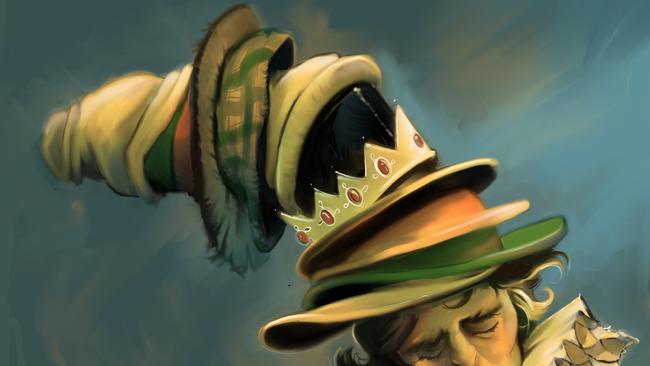Schizophrenia: Let’s not fear the illness that wears so many hats

In a recent brief newspaper report of the tragic case of Liam Anderson, the 26-year-old son of singer Angry Anderson who was bashed to death by a friend, the word schizophrenia is mentioned four times. Any reader asked afterwards to play the word-association game would almost undoubtedly respond to the prompt “schizophrenia” with the words “murder” or “violence”. Yet the dull, unlikely-to-grab-headlines fact is that those with schizophrenia are eight times more likely than average to be the victim of violence.
The first thing I learned about schizophrenia is that, for many people, the mere word provokes terror. It seems difficult for people to say out loud. The very shape and sound of the word in our mouths is unpalatable. Schiz-o-phren-i-a. Five small, self-respecting syllables that amount to what has been described as “the scariest word in the English language”.
The second thing I learned is how hard it is for people to hear it when you do dare to say the word out loud in public. You see eyes darting for the nearest escape door, the expression of embarrassment, the intense fear — almost as though the utterance itself might lead to contagion. In A Beautiful Mind, the book about Nobel prize-winning economist and mathematician John Forbes Nash, the biographer observed that the defining characteristic of schizophrenia, more than any actual symptom, is the profound fear that it provokes in others.
The third thing I learned was how few stories, novels and films featured characters with schizophrenia. As a writer and compulsive reader, I am still waiting to come across a novel featuring a character or a narrator with schizophrenia. (Although a Shakespeare scholar tells me he suspected Hamlet displayed many symptoms.) Surely the reason for ignoring the creative potential for a character with schizophrenia can’t be because they are too boring: hearing voices, hallucinations, delusions — it’s the stuff of drama. Is the word also too frightening for them?
As part of the new wave of intelligent TV, other mental illnesses have been successfully mined for their capacity for creating complex and fascinating characters. We have seen a woman with bipolar disorder as the lead in the American series Homeland, and a delusional, hallucinating psychotic character as the lead in Mr Robot. In this age of diversity and inclusion, I am wondering when we will see an attempt to create a screen story featuring a character with schizophrenia (and preferably one who isn’t a serial killer).
It’s not true that schizophrenia has been completely ignored by filmmakers and storytellers; it is simply that it has been used almost exclusively to provide ready-made “psychos”, based on the mistaken but common perception that those with schizophrenia are inherently violent. The result is that of the 628 films listed on IMBD with schizophrenia mentioned in the plot, the majority are horror or slasher films. (So why wouldn’t we, the viewers, find the word scary?)
There is a notable exception: a 1995 Australian film featuring Colin Friels, Jacqueline MacKenzie, Deborah Lee-Furness and Robyn Nevin. Angel Baby tells the story of two young people with schizophrenia. The film is a gentle, funny, devastatingly accurate portrayal, showing a young couple doing what young couples do — falling in love, moving in together and then getting pregnant — except these simple things, for people with schizophrenia, are incredibly difficult, partly because of their condition, but largely because of how they are treated and perceived by others.
What makes this film even more outstanding is that the word schizophrenia is never mentioned. The only way we can be certain the couple suffers from it is because of one brief scene, featuring a young MacKenzie, reading from Surviving Schizophrenia, a well-known family manual published in 1983, and in its ninth edition. The film swept the awards in 1995 and may have heralded of a new way of telling stories about schizophrenia. But it didn’t.
I wonder if the reason we’re frightened of schizophrenia, a condition researchers refer to as the extreme end of a “psychotic disorder spectrum” — a poorly understood group of disorders including bipolar and schizoaffective disorder — is that many of us have a deep fear that we too, we ordinary, not mentally ill people, have the potential to become psychotic. Indeed, some researchers argue that psychosis is a reasonable response to an unbearable situation, and that given enough stress all of us are capable of becoming psychotic. Psychosis, some believe, is a language for something that doesn’t have a language. It is its own particular and strange way of making meaning.
It is time for us to start talking about and reporting schizophrenia in a way that doesn’t perpetuate and reinforce images and ideas so effectively portrayed in Hitchcock’s Psycho and that continue — ably assisted by the constant stream of crime stories linking violence with schizophrenia — to this day.
When a journalist emphasises a diagnosis of schizophrenia in their story about a violent crime, they help make the word unspeakable and punish the overwhelming majority of those suffering from it for whom the worst symptom of the condition is social rejection. Schizophrenia is ranked the 13th most disabling disorder according to the Global Burden of Disease. News reporters and storytellers more widely need to take some responsibility not to increase that burden.
Gabrielle Carey is the author of Only Happiness Here (UQP). @Gabrielle_Care

